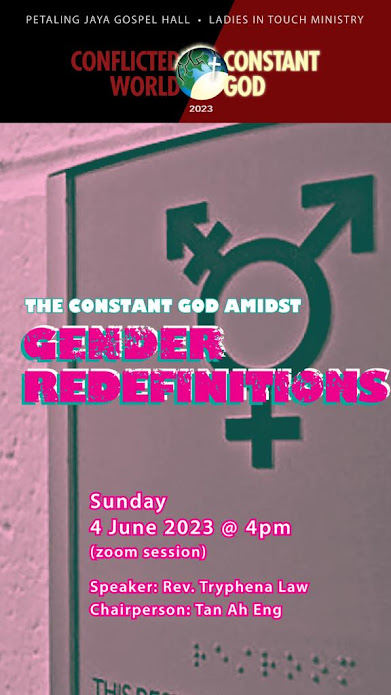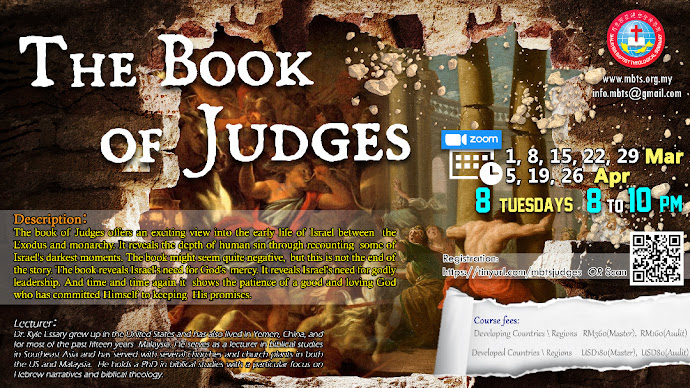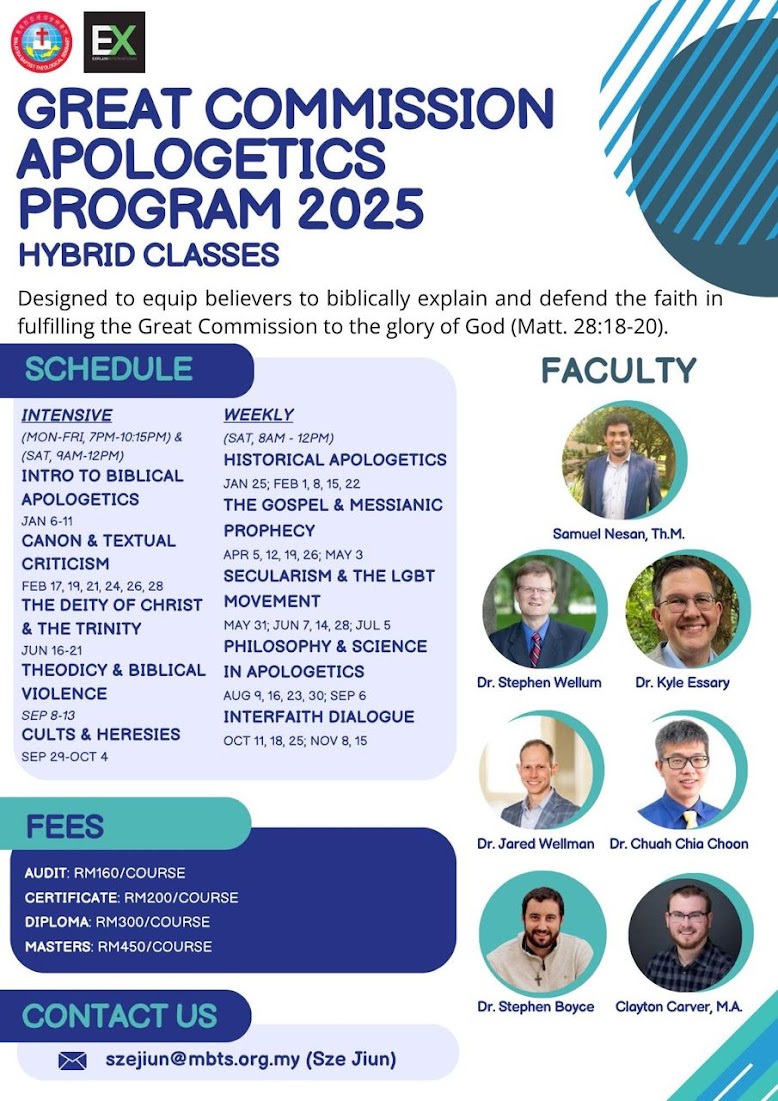THE USE OF PARABLES IN MATTHEW'S GOSPEL IN EXPOUNDING THE KINGDOM OF HEAVEN
By Stephen Ng
Introduction
Different Responses to the Kingdom Expected
Potential for Gradual Growth
The Good and the Bad Together
Kingdom Values
Grace and Correct Response, Not Human Efforts
On Being Prepared
Conclusion
References
Introduction
The Gospel of Matthew was written in around AD 70. Some believe it
was written at a time when the Temple of Jerusalem had been destroyed by the
Romans, while others argued that it was completed before the invasion of
Jerusalem. According to early church fathers such as Irenaeus,
Origen, Eusebius and
Gregory Nazianzen, the gospel presented Jesus as both
the promised Messiah and the great Davidic King to the Jewish community. It
also sought to address their needs as they were facing the challenges posed by
a Pharisaic religious establishment (Berkhof 2004, 35) . The gospel then concluded with the Great Commission to share the
gospel with the rest of the Gentile world (Keener 1993,
43-45) .
According to Aune, Matthew organized his contents “around a common
theme”, and “often very tightly focused and appears to be designed for teaching”[1]
(Aune 2010, 301) . All of Jesus’ parables had both the “mysterious
element” and the interpretations. According to Hagner, faith is the key to
understanding these parables (Hagner 2012, 76) ; otherwise, the parable would be
nothing but a story (Aune 2010, 301) (Keener 1993, 82) . Faith is what gives
a new dimension of Kingdom truths to what every scribe would have learnt from
the Jewish scripture (Matthew 13:52) (Martin
2012, 103)
The focus of this assignment is to unravel the secrets or mysteries
of the Kingdom of God in these parables.
Different Responses to the Kingdom Expected
In the Parable of the Soils[2],
Jesus’ focus was on the seed and the soils. The seed is the message of God’s
kingdom, while the soil is the people’s reception to the message. The harvest therefore
depended directly on the condition of the soil that the seed was sown into. It
could produce any of the four types of responses from the people.
(a)
The hard pathway. With
almost no soil on it, the moment the seed was sown on the pathway, the birds took
them away. Therefore, the seed had no chance to even sprout. The kingdom of God
did not belong to these people because they heard God’s word, but they did not
take it seriously. Soon, everything they heard was forgotten altogether.
(b)
Rocky places. There was a
little soil there, which allowed the seed to sprout but soon, the seedling was
scorched by the hot sun and it withered. There were among the audience people who
would gladly receive the kingdom of God, but because they lacked a sense of
depth, the knowledge of God and his kingdom would soon dissipate away when
hardship struck.
(c)
Thorny bush. According to
Keener, rabbis had a saying that “one would be consumed with either the law or
with the cares of this world (Matthew 13: 22)” (Keener 1993, 83) . In Matthew 6:33,
Jesus had taught that the Kingdom of God and his righteousness was the
antithesis of materialism. In short, Jesus was also warning the people that
their worries of their physical needs would crowd out the initial desires to
know more about God’s kingdom.
(d)
Finally
the Fertile Soil. Jesus taught that
the Kingdom of God was clearly for those who had some depth of fertile soil.
This allowed the seed to sprout and eventually produce a good crop.
Through this parable, Jesus taught that the Kingdom of God was all
about how different people responded to the kingship of Jesus in their lives; ultimately,
each person would be responsible for his or her response to the word about the
Kingdom.
Using the Parable of the two
sons (21:28-32), Jesus again addressed the stubbornness of the religious
teachers in his days. Like the first son, they resisted the word that would
eventually usher in the kingdom of God, whereas the younger son, who initially
rejected the word, repented. It is the latter that would experience God’s
kingdom.
Potential for Gradual Growth
Through another parable of the Mustard Seed, Jesus
taught that the kingdom of God was expected to grow from a simple group of
followers (13: 31-32). it would have a humble beginning like the mustard seed.
Despite being the most inconspicuous and probably the smallest seed known in
Jesus’s time, it had the potential to someday grow into a large shrub as tall
as 15 feet that could provide a place for the fowls of the air. (Keener 1993, 83) . This was contrary to the expectations of the
Jews who thought that the kingdom of God would “arrive in a blaze of glory with
military victories over the gentile power” (Gundry 1981, 141) .
The parable of the leaven (or
yeast) conjures the imagery of a Galilean woman, rather than a baker, who
would mix leaven (or yeast) into three pecks of flour to prepare a meal[3].
According to Gundry, this was to show that the kingdom of God may begin with
only a pinch of yeast, but despite being insignificant, it could eventually
leaven a big lump of dough.
The Good and the Bad Together
Jesus contrasted his teaching about the kingdom from the Essene
community and the religious teachers of his days[4].
Using the illustration of the wheat and
tares (13: 24-30, 36-43), he taught that until the time came for the
eschatological judgment, Christians would have to live with those who belong to
Satan (Hagner 2012, 76) . His audience who
were farmers would understand the illustration very well, but the truths of the
kingdom were hidden from them due to their expectation that the Messiah would
come as a saviour to deliver them from the powerful Romans.
Jesus again illustrated the same point using a different parable in
Matthew 13: 45-46 (Parable of the
Dragnet), which targeted at the fishing community. The dragnet would haul
in all types of fish, after which the good fish had to be separated the bad
fish. The ‘bad’ fish was those that were ceremonially unclean and based on
Mosaic laws, should not be consumed “due to a lack of scales or fins” (Gundry 1981, 142) . In God’s kingdom,
the good and the bad would have to remain together until a certain timeline,
when the angels would sort out those who belong to the kingdom and those who
are not.
This teaching about the kingdom of God is further reinforced in
Jesus’ teaching about God’s final judgement, when the sheep would be separated
from the goat (25:31-46). Until then, both the good and the bad would have to
co-exist even within the church. Such would be the kingdom of God in the
present times; however, a time will come when only those who belonged to the
kingdom of God would be ushered into the eternal kingdom.
Kingdom Values
Earlier, Jesus had taught the multitude to “seek first the kingdom
of God and his righteousness” (6:33). Kingdom values were reiterated through the
Parable of the Costly Pearl
(13:45-46). During Jesus’ time, divers would look for precious pearls in the
Red Sea, Persian Gulf and Indian Ocean. Pearls were priceless jewels.
Due to frequent invasion and looting by foreign armies, it was
common for people to bury their treasures. When the hidden treasure was found,
and there was no claim of ownership due to the death of the owner, the ethical
thing to do based on the law of the day was to buy the land in which the hidden
treasure was buried (Gundry 1981, 142) . Through this Parable of the Hidden Treasure (13: 44), Jesus again emphasized on
the greater treasure that one should be seeking after in pursuit of God’s
kingdom.
Grace and Correct Response, Not Human Efforts
In the parable of the vineyard workers
(20:1-16), Jesus taught that the kingdom of God was based solely on God’s
grace, not on human efforts. The unskilled labourers were hired at different
times of the day (6am, 9am, 12 noon, 3pm, 5pm) and paid their daily wage of one
Denarius. It was the wage that had been agreed upon irrespective of the time
they clocked in. It was also based on the standard wages during Jesus’ time. Logically,
the workers who were hired at 6am would have become exhausted by about noon time.
Those who came in later were to be more energetic and eager to work; therefore,
they collectively offset the tardiness of the earlier batch of workers. Their
productivity level therefore merits the wages they were eventually paid.
Unlike the Pharisees who
taught that observance of the Law would win God’s favour, Jesus emphasized that
the kingdom of God was set up solely based on God’s grace and the people’s
response. To illustrate this further, Jesus used the Parable of the Landowner (21: 33-46) to show how the landowner had shown
mercy towards the wicked tenants. In those days, the landowners had their
squads of hired assassins. An otherwise merciless landowner would have
obliterated the rebellious tenants; however, in this case, it was the tenants
who acted as if they were the ones with power, and they exploited it
mercilessly. Jesus used this parable to illustrate Israel’s wrongdoing over the
years, when they martyred many of the prophets God sent (Keener 1993, 103) . Through it, Jesus
also taught that this particular landowner, who is none other than God himself,
was prepared to allow his own son to be killed before he eventually sent his
men to deal with the wicked tenants. They
had no right to remain as tenants.
The kingdom of God includes even the Gentiles, a point which Jesus
further reinforced using the Parable of
the Marriage Feast. Entry into the feast is strictly depending by royal
invitation (22:1-14). Through it, he sent a strong message to the unbelieving
Jews – especially the religious teachers during his times – that they would
meet their tragic end if they chose to reject God’s kingdom. No one has the
right to question why God rejected Israel, instead welcomed the Gentiles into
the Kingdom. This is strictly on one condition – they had to put on the wedding
clothes when they attended the Marriage Feast, failing of which would be an
insult to the king himself.
In his teaching about the kingdom of God, Jesus also warned against
the Pharisaic attitude and sense of self-righteousness, which hindered them
from receiving Jesus as the Messiah, unlike the “sinners” in their midst. This
was again emphasized in the Parable of
the Two Sons (21:28-32), where the Pharisees were compared to the elder son
who refused to feel remorse and accept Jesus as the Messiah.
On Being Prepared
Using the illustration of the thief in the night (24: 42-44), Jesus
taught that he would return to claim the kingdom at a time when no one expects.
In Chapters 24 and 25, Jesus’ parables were targeted mainly at the disciples.
They have the element of being ‘watchful’ of the season when Christ would
return. Israel was described as the fig tree (24: 32-41) which would indicate
the signs of end times. Through the Parable
of the watchful servant (24: 42-51), Jesus taught that one has to keep watching
and be prepared for his return.
Those invited to the Marriage Feast would therefore need to prepare
themselves like the five wise virgins in the Parable of the Ten Virgins (25:1-13) who had sufficient oil for
their lamp stands. In God’s kingdom, those invited who were eventually not
allowed to participate in the Marriage Feast were either those who did not put
on the wedding garment fit for a grand feast (22:11-14) or totally ill-prepared
for the coming of the Messiah (25:10-12). Not everyone who is called would be
chosen, “for many are called, but few are chosen” (22:14). Therefore, entry into the
kingdom of God would require one to be constantly alert (24:42).
Teaching about good stewardship, using the Parable of the Talents (25:14-30), Jesus taught his disciples to be
fruitful and multiply, using whatever resources that they had been given. The
kingdom of God is such that when the master returns, he will reward the good
stewards based on their faithfulness, seen through their ability to manage
their talents, which included time, money, abilities (whether natural or
spiritual gifts), and other resources.
Conclusion
The parables Jesus told the
people of Israel were mainly to illustrate the Kingdom of God on what it was
and what it was not. Because of their lack of faith, they were unable to
understand the parables. The disciples were, however, given the additional
insights into the meaning of the parables. These parables were mainly about the
kingdom of God in the present day. To the disciples, they were also told more
about the future manner in which the kingdom of God would eventually take
shape.
References
Aune, David E., ed. The
Blackwell Companion to the New Testament. Chichester, West Sussex:
Blackwell Publishing Ltd, 2010.
Berkhof, Louis. Introduction to the
New Testament. Grand Rapids, MI: Christian Classics Ethereal Library,
2004.
Carson, D. A., Douglas J. Moo, and Leon
Morris. An Introduction to the New Testament. Grand Rapids, MI:
Zondervan Publishing House, 1992.
Gundry, Robert H. A Survey of the New
Testament. Vol. 381. Grand Rapids, MI: Zondervan Publishing House , 1981.
Hagner, Donald A. . The New Testament:
A Historical and Theological Introduction. Grand Rapids, MI: Baker
Publishing Group, 2012.
Keener, Craig S. The IVP Background
Commentary - New Testament. 1 vols. Downers Grove, IL: InterVarsity
Press, 1993.
Lea, Thomas D. The New Testament - Its
Background and Message. Nashville, Tennesse: Broadman & Holman
Publishers, 1996.
Martin, Dale B. New Testament history
and literature. Yale University Press, 2012.
[1] For
example, seven of Jesus’ parables in Chapters 13 were spoken specifically to
Israel as a nation, and another seven parables in Matthew 24 and 25 which
taught about the ‘future-kingdom’, when Christ shall come to claim the kingdom (Keener
1993, 115) .
[2]
Theologians such as Gundry agree that the title, “Parable of the Sower” can be
misleading (Gundry 1981, 139) ; hence, others have called it the “Parable of the Soils” (Carson,
Moo and Morris 1992, 65) .
[3]
Three pecks of flour was equivalent to about 50lbs of flour (13: 33-35).
[4] During Jesus’ time, the religious teachers and the Essene community
distanced themselves from the common people (Gundry 1981,
47-51) .
Jesus taught his disciples that in God’s kingdom at the present time, they had
to mingle around with their contemporaries until the eschatological judgement
came when the wicked ones would be removed. Tares were a kind of ryegrass or “a
poisonous weed, which appeared like the wheat in the early stages and could
only be distinguished from it when the ear appeared” (Keener 1993, 83) . If the farmer made
any attempt to weed out the tares in the springtime, he would risk uprooting
the wheat at the same time. Eventually, the wheat would have to be cut just
below the head, while the shorter tares would be cut separately, dried and used
as fuel for burning.




Comments
Post a Comment